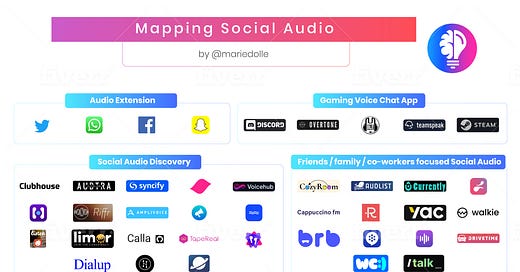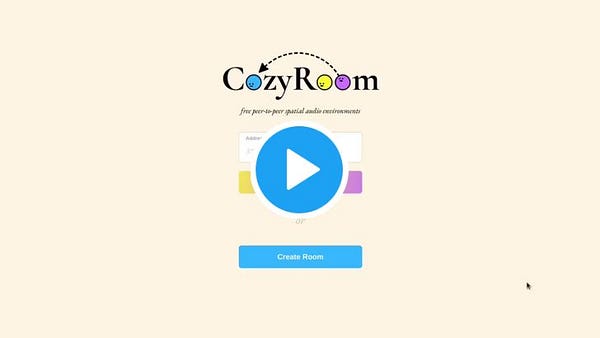The rise of Social Audio Apps
Clubhouse, Cappucino, Roadtrip ... in the last few months, social audio apps have proliferated to seduce us ... and serve us better? Here's all you need to know.
Mapping out Social Audio apps
Yeah, I love mapping. I tried it on the previous article, apparently people liked it, so I'll give it another shot here :-). With a little methodology note by way of preamble: this mapping doesn't include podcasting hosts or broadcasters; I also excluded live podcasting apps. If you want an overview of these ecosystems, you can read this report by Andrew Chen. Why repeat something that has already been done and done well?
Map updated on the 02/07/2020
So I focused on so-called "social" audio apps, which I've classified for the moment into four categories:
Audio extensions for traditional horizontal social networks like CatchUp, Facebook's audio chat or the audio tweets from Twitter.
Audio chat apps mainly related to gaming like Discord or Overtone. If these apps have been around for a long time, I'm sure they will evolve and become more creative, especially with the explosion of online gaming.
Social Audio Apps mostly focused on family or friends in B2C or around work colleagues in B2B.
Social Audio Apps that encourage "social discovery" by allowing you to discover and connect with new people.
Of course, the lines are sometimes very porous; I remain convinced that the social component will escape from silos on dedicated apps to feed everywhere else - social by design. Says the discovery features like the Apple Music follow feature or the QR codes in Spotify to share content more easily with friends.
Please note, however, that this is a work in progress and I welcome all your feedback. To that end, here you'll find an Airtable updated on a regular basis
Perfect time to market ?
An interesting point to underline: this ecosystem is still fragile. A dozen players that have emerged over the last three years have already gone out of business (hence their absence from the mapping). Lack of audience? Difficulties in generating momentum? Complex monetization? Things are starting to change, and the current climate could be more favorable to the development and sustainability of social audio apps for four reasons:
The rise in popularity and the craze for podcasts has generally favored the audio format: 75% of Americans are Now Familiar with Podcasting according to a study from Edison Research and Triton Digital . This is approximately 212 million people and an increase of more than 10 million in one year
Let's also mention hardware developments. If for instance mobile has facilitated the advent of Uber, the phenomenal success of Airpods (Apple estimates that 85 million models could be sold in 2020) opens up new opportunities. A social network had even been created around Airpods; TTYL unfortunately has been forced to close, without having federated a community strong enough to continue. Was this too early? An interesting site is positioned as the "Air Pods Apple Store" - although it is not affiliated to the Apple store - that lists all the major applications for AirPods. A trend that goes hand in hand with the development of IoT in general, especially smart speakers. Audio can be declined in monotasking and multitasking, with a progressive anchoring in the development of natural interfaces and eventually the ambient web.
Audio now accesses existing audience pools, notably through Snapchat. This ecosystem is becoming more and more open, especially since the launch in 2018 of SnapKit, which enables the use of the social network in third-party applications.
The current context, the economic and health crisis, and the digitalization of our lives are pushing us to seek more intimate digital experiences, especially those that combine entertainment, spontaneity and socialization. And what could be more personal than voice?
Distinctive audio concepts!
I had a chance to talk with Gilles Poupardin, one of the founders of an application called Cappucino. Gilles explained to me that we don't consume audio like text and video. He believes audio lives badly when mixed with text, so the design of an audio app must be different. He also does not believe in audio feed alone, convinced that it is necessary to work on new concepts that are distinctive enough. This is why he developed Cappucino: "If Snap is the camera company, Cappucino is the microphone company". Witnessing the rise of podcasts, he wanted to develop a "less polished", more intimate format. Cappucino delivers your friends' audio messages every morning in the form of an audio show mixed with music. It is an asynchronous application: friends record daily “beans”, which are then mixed by the app; you receive your "cappucino", a mini show orchestrating your friends' voices. Currently in beta, the application is already making headlines and bringing together regular users.


Other apps have caught my attention
Some of them are rather "hype": Clubhouse recently raised 10 million dollars from Andreessen Horowitz. The concept? Audio virtual conference rooms plunged in the dark where people discuss, sometimes for hours, as some users pointed out. Let's also mention RoadTrip which is also very interesting.

I tested the app Toodeep that allows users to anonymously express their emotions to equally anonymous people. We're not going to lie to each other, it's quite depressing. But it could be an interesting vertical for online psychology and therapy, a field that is growing and that Patricia Mou has mapped out on her Substack, you can read it here.
Let's also mention Wavechat which is positioned as the "Snapchat of audio" and offers "voice filters", transcriptions and the possibility to associate memes and emojis editing to illustrate the recording. In short, a very gamified and distinctive universe.
As I write these lines, another app is about to launch: Too Long; Didn’t listen, a social podcasting app and I’m sure it’s worth watching.
Finally, Cozyroom has just been launched, which offers a fun way to chat and spend time with friends thanks to spatial audio environments. The experience is worth the visit, I highly recommend it.
Beating "Zoom fatigue"!
Audio is not restricted to the B2C ecosystem! Quoted previously, Gilles Poupardin explains to me that he sees interesting use cases appearing on Cappucino, in particular a manager who uses the app for his stand-up management!
Other tools are being developed specifically for this market. Let's mention the application Yac, which offers an asynchronous voice chat limited to 120 seconds so that interactions between employees are fast, precise and clear. It should also be noted that the company has developed its B2C counterpart, BrB, for a more playful use.
A special feature of this service is that it is positioned as a real alternative to Zoom by allowing conversations that go "straight to the point" and replays: everything is stored there, as audio recordings are limited to two minutes, there is a better chance that Internet users will come back to consult them. In short, the company that uses Yac takes back control of its agenda and its time... to ultimately gain in productivity!
Audio social is future? It could well be. Day after day, new applications appear, new uses. There is a good chance that this article will have to be seriously completed within six months. Let's meet again to review it, of course. In the meantime, feel free to share your own experiences on the subject, the way you use these tools, how they boost your creativity, your business. I look forward to hearing from you.
Many thanks to those who participated or reviewed this mapping, including Raphael Greico, Vinay Taylor, Vidy Thatte, Azlen Elza, Dave Goldblatt.









Incredible post Marie! Thanks so much for sharing. Could you possibly share the names of the companies under the Social Audio Discovery section? It's hard to find the companies without names in the logo.
Don't forget to add on the hardware developments audio car development, speakers can be Bluetoothed ;-) Not mentioning AI systems with Alexa and Google Home.